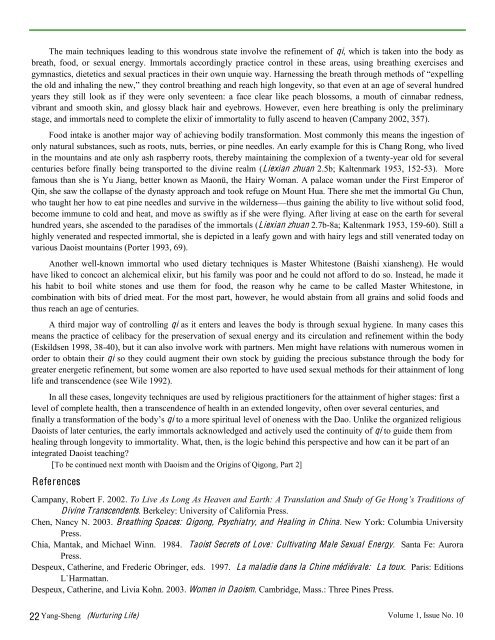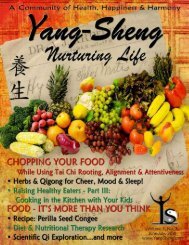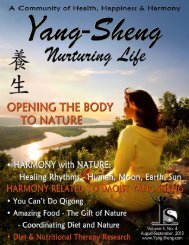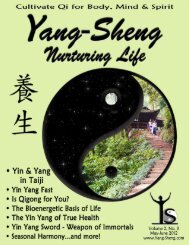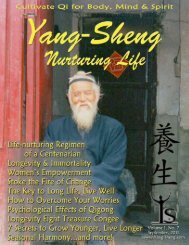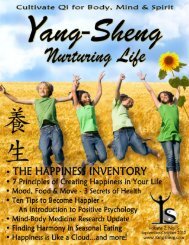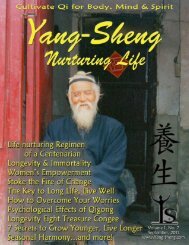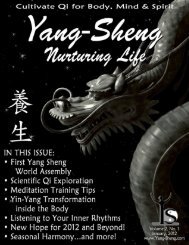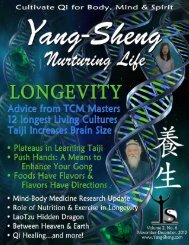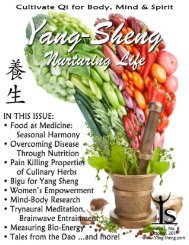Download the December issue of Yang-Sheng as
Download the December issue of Yang-Sheng as
Download the December issue of Yang-Sheng as
You also want an ePaper? Increase the reach of your titles
YUMPU automatically turns print PDFs into web optimized ePapers that Google loves.
The main techniques leading to this wondrous state involve <strong>the</strong> refinement <strong>of</strong> qi, which is taken into <strong>the</strong> body <strong>as</strong><br />
breath, food, or sexual energy. Immortals accordingly practice control in <strong>the</strong>se are<strong>as</strong>, using breathing exercises and<br />
gymn<strong>as</strong>tics, dietetics and sexual practices in <strong>the</strong>ir own unquie way. Harnessing <strong>the</strong> breath through methods <strong>of</strong> “expelling<br />
<strong>the</strong> old and inhaling <strong>the</strong> new,” <strong>the</strong>y control breathing and reach high longevity, so that even at an age <strong>of</strong> several hundred<br />
years <strong>the</strong>y still look <strong>as</strong> if <strong>the</strong>y were only seventeen: a face clear like peach blossoms, a mouth <strong>of</strong> cinnabar redness,<br />
vibrant and smooth skin, and glossy black hair and eyebrows. However, even here breathing is only <strong>the</strong> preliminary<br />
stage, and immortals need to complete <strong>the</strong> elixir <strong>of</strong> immortality to fully <strong>as</strong>cend to heaven (Campany 2002, 357).<br />
Food intake is ano<strong>the</strong>r major way <strong>of</strong> achieving bodily transformation. Most commonly this means <strong>the</strong> ingestion <strong>of</strong><br />
only natural substances, such <strong>as</strong> roots, nuts, berries, or pine needles. An early example for this is Chang Rong, who lived<br />
in <strong>the</strong> mountains and ate only <strong>as</strong>h r<strong>as</strong>pberry roots, <strong>the</strong>reby maintaining <strong>the</strong> complexion <strong>of</strong> a twenty-year old for several<br />
centuries before finally being transported to <strong>the</strong> divine realm (Liexian zhuan 2.5b; Kaltenmark 1953, 152-53). More<br />
famous than she is Yu Jiang, better known <strong>as</strong> Maonü, <strong>the</strong> Hairy Woman. A palace woman under <strong>the</strong> First Emperor <strong>of</strong><br />
Qin, she saw <strong>the</strong> collapse <strong>of</strong> <strong>the</strong> dyn<strong>as</strong>ty approach and took refuge on Mount Hua. There she met <strong>the</strong> immortal Gu Chun,<br />
who taught her how to eat pine needles and survive in <strong>the</strong> wilderness—thus gaining <strong>the</strong> ability to live without solid food,<br />
become immune to cold and heat, and move <strong>as</strong> swiftly <strong>as</strong> if she were flying. After living at e<strong>as</strong>e on <strong>the</strong> earth for several<br />
hundred years, she <strong>as</strong>cended to <strong>the</strong> paradises <strong>of</strong> <strong>the</strong> immortals (Liexian zhuan 2.7b-8a; Kaltenmark 1953, 159-60). Still a<br />
highly venerated and respected immortal, she is depicted in a leafy gown and with hairy legs and still venerated today on<br />
various Daoist mountains (Porter 1993, 69).<br />
Ano<strong>the</strong>r well-known immortal who used dietary techniques is M<strong>as</strong>ter Whitestone (Baishi xiansheng). He would<br />
have liked to concoct an alchemical elixir, but his family w<strong>as</strong> poor and he could not afford to do so. Instead, he made it<br />
his habit to boil white stones and use <strong>the</strong>m for food, <strong>the</strong> re<strong>as</strong>on why he came to be called M<strong>as</strong>ter Whitestone, in<br />
combination with bits <strong>of</strong> dried meat. For <strong>the</strong> most part, however, he would abstain from all grains and solid foods and<br />
thus reach an age <strong>of</strong> centuries.<br />
A third major way <strong>of</strong> controlling qi <strong>as</strong> it enters and leaves <strong>the</strong> body is through sexual hygiene. In many c<strong>as</strong>es this<br />
means <strong>the</strong> practice <strong>of</strong> celibacy for <strong>the</strong> preservation <strong>of</strong> sexual energy and its circulation and refinement within <strong>the</strong> body<br />
(Eskildsen 1998, 38-40), but it can also involve work with partners. Men might have relations with numerous women in<br />
order to obtain <strong>the</strong>ir qi so <strong>the</strong>y could augment <strong>the</strong>ir own stock by guiding <strong>the</strong> precious substance through <strong>the</strong> body for<br />
greater energetic refinement, but some women are also reported to have used sexual methods for <strong>the</strong>ir attainment <strong>of</strong> long<br />
life and transcendence (see Wile 1992).<br />
In all <strong>the</strong>se c<strong>as</strong>es, longevity techniques are used by religious practitioners for <strong>the</strong> attainment <strong>of</strong> higher stages: first a<br />
level <strong>of</strong> complete health, <strong>the</strong>n a transcendence <strong>of</strong> health in an extended longevity, <strong>of</strong>ten over several centuries, and<br />
finally a transformation <strong>of</strong> <strong>the</strong> body’s qi to a more spiritual level <strong>of</strong> oneness with <strong>the</strong> Dao. Unlike <strong>the</strong> organized religious<br />
Daoists <strong>of</strong> later centuries, <strong>the</strong> early immortals acknowledged and actively used <strong>the</strong> continuity <strong>of</strong> qi to guide <strong>the</strong>m from<br />
healing through longevity to immortality. What, <strong>the</strong>n, is <strong>the</strong> logic behind this perspective and how can it be part <strong>of</strong> an<br />
integrated Daoist teaching?....................................................................................................................................................<br />
[To be continued next month with Daoism and <strong>the</strong> Origins <strong>of</strong> Qigong, Part 2]<br />
References<br />
Campany, Robert F. 2002. To Live As Long As Heaven and Earth: A Translation and Study <strong>of</strong> Ge Hong’s Traditions <strong>of</strong><br />
Divine Transcendents. Berkeley: University <strong>of</strong> California Press.<br />
Chen, Nancy N. 2003. Breathing Spaces: Qigong, Psychiatry, and Healing in China. New York: Columbia University<br />
Press.<br />
Chia, Mantak, and Michael Winn. 1984. Taoist Secrets <strong>of</strong> Love: Cultivating Male Sexual Energy. Santa Fe: Aurora<br />
Press.<br />
Despeux, Ca<strong>the</strong>rine, and Frederic Obringer, eds. 1997. La maladie dans la Chine médiévale: La toux. Paris: Editions<br />
L`Harmattan.<br />
Despeux, Ca<strong>the</strong>rine, and Livia Kohn. 2003. Women in Daoism. Cambridge, M<strong>as</strong>s.: Three Pines Press.<br />
22 <strong>Yang</strong>-<strong>Sheng</strong> (Nurturing Life) Volume 1, Issue No. 10


